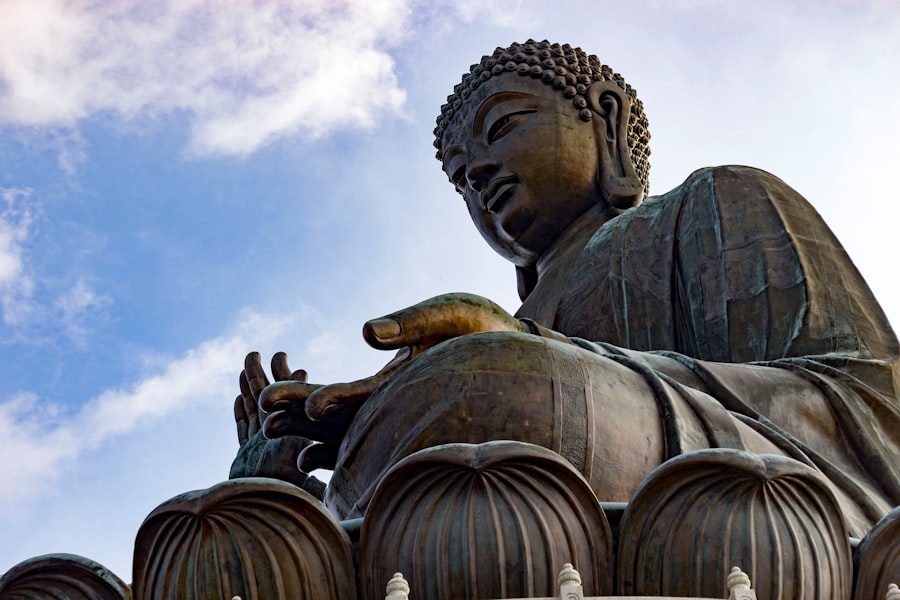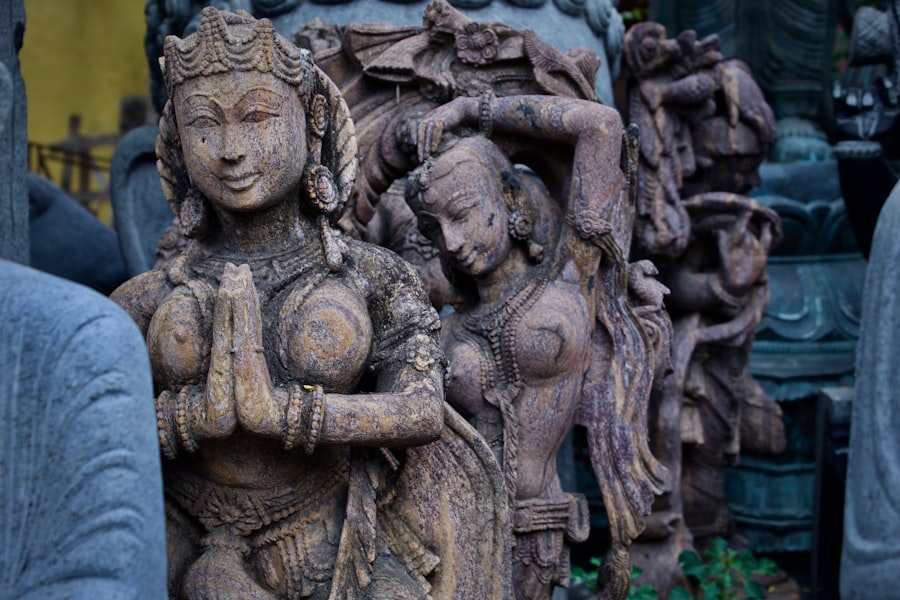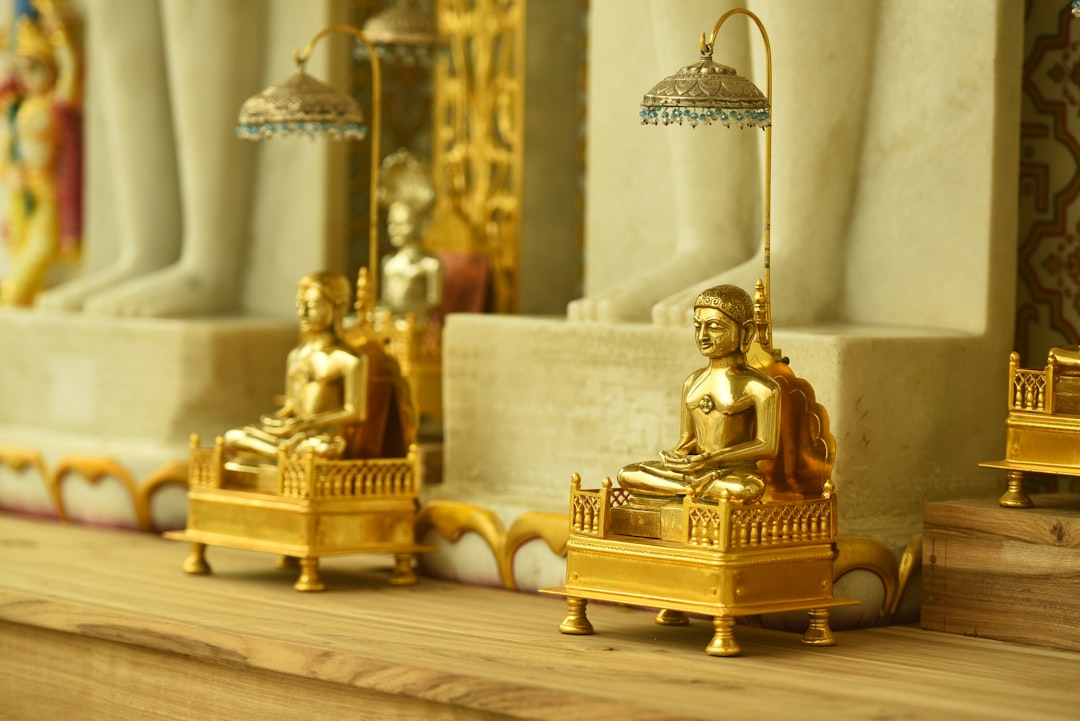Gupta Art, flourishing during the Gupta Empire from approximately the 4th to the 6th centuries CE, represents a significant period in Indian history characterized by remarkable advancements in various fields, including art, literature, and science. This era is often referred to as the “Golden Age” of India due to its profound cultural and intellectual achievements. The art produced during this time is distinguished by its exquisite craftsmanship, intricate detailing, and a harmonious blend of spiritual and secular themes.
The Gupta period saw the emergence of a unique artistic style that not only reflected the religious sentiments of the time but also showcased the socio-political dynamics of the empire. The Gupta artists were adept at various forms of artistic expression, including sculpture, painting, and architecture. Their works often depicted deities from Hinduism and Buddhism, illustrating the syncretic nature of Indian spirituality during this period.
The emphasis on naturalism and human emotion in Gupta art marked a departure from earlier artistic traditions, leading to a more relatable and accessible representation of divine figures. This evolution in artistic expression not only enriched the cultural landscape of India but also laid the groundwork for subsequent artistic movements in the region.
Key Takeaways
- Gupta art is a significant period in Indian art history known for its exquisite sculptures and architectural achievements.
- Mathura is considered the birthplace of Gupta art, where the style first emerged and flourished.
- Sarnath became the center of Gupta artistic innovation, showcasing the development of new techniques and styles.
- Gupta art extended beyond Mathura and Sarnath, leaving its mark on various regions of India through its unique artistic expressions.
- The influence of Gupta art on Indian culture and religion is profound, with its sculptures and architectural designs reflecting the values and beliefs of the time.
Mathura: The Birthplace of Gupta Art
Mathura, located in present-day Uttar Pradesh, is often regarded as the cradle of Gupta art. This ancient city was a thriving center for trade and culture, attracting artisans and scholars from various parts of India. The artistic legacy of Mathura is particularly notable for its sculptures, which are characterized by their detailed craftsmanship and emotive expressions.
The Mathura school of art played a pivotal role in shaping the stylistic elements that would later define Gupta art as a whole. One of the most significant contributions of Mathura to Gupta art is the development of the iconic image of the Buddha. The Mathura style emphasized a more humanized portrayal of the Buddha, moving away from the abstract representations that preceded it.
Sculptures from this period often depict the Buddha with distinct features such as elongated earlobes, a serene expression, and a graceful posture. This humanization of divine figures made them more relatable to devotees and marked a significant shift in religious iconography. In addition to Buddhist sculptures, Mathura was also known for its depictions of Hindu deities.
The intricate carvings found in temples and shrines reflect the rich tapestry of religious beliefs that coexisted during this time. The artistic techniques developed in Mathura, such as the use of drapery to convey movement and depth, became foundational elements in Gupta art. As a result, Mathura’s influence extended far beyond its geographical boundaries, setting the stage for a flourishing artistic tradition that would resonate throughout the Gupta Empire.
Sarnath: The Center of Gupta Artistic Innovation

Sarnath, located near Varanasi, holds immense significance in the history of Gupta art as a center for artistic innovation and religious scholarship. It is famously known as the site where Gautama Buddha delivered his first sermon after attaining enlightenment. This historical context made Sarnath a pilgrimage destination for Buddhists and an important hub for artistic expression related to Buddhism.
The Sarnath school of art is particularly renowned for its sculptures that embody a sense of serenity and grace. The famous Lion Capital of Ashoka, which was discovered at Sarnath, exemplifies the high level of craftsmanship achieved during this period. The capital features four lions standing back to back on a circular abacus adorned with intricate carvings of animals and floral motifs.
In addition to sculpture, Sarnath was also a center for mural painting during the Gupta period. The frescoes found in various stupas and monasteries depict scenes from the life of Buddha and other significant Buddhist narratives.
These murals are notable for their vibrant colors and dynamic compositions, showcasing the artists’ mastery over form and color. The innovations in both sculpture and painting that emerged from Sarnath contributed significantly to the overall development of Gupta art, influencing subsequent generations of artists across India.
Gupta Art Beyond Mathura and Sarnath
While Mathura and Sarnath are often highlighted as key centers of Gupta art, the influence of this artistic movement extended far beyond these locales. Various regions across India embraced Gupta artistic styles, adapting them to local traditions and cultural contexts. For instance, regions such as Ajanta and Ellora became prominent sites for rock-cut architecture and cave paintings that exemplified Gupta artistic principles.
The Ajanta Caves, a UNESCO World Heritage site, are particularly noteworthy for their stunning frescoes and intricate sculptures that date back to the Gupta period. These caves served as monastic retreats for Buddhist monks and are adorned with elaborate murals depicting Jataka tales—stories illustrating the previous lives of Buddha. The use of vibrant colors, intricate detailing, and expressive figures in these paintings reflects the high level of artistic achievement during this era.
The Ajanta Caves stand as a testament to how Gupta art transcended its origins, influencing regional styles while maintaining its core aesthetic values. Similarly, the rock-cut temples at Ellora showcase a blend of Hindu, Buddhist, and Jain architectural styles that flourished during the Gupta period. The Kailasa temple at Ellora is an architectural marvel carved entirely out of a single rock, demonstrating not only artistic ingenuity but also engineering prowess.
The intricate carvings adorning the temple walls depict various deities and mythological narratives, embodying the spiritual essence that characterized Gupta art. This cross-pollination of artistic styles across different regions illustrates how Gupta art became a unifying force in Indian culture during its time.
Influence of Gupta Art on Indian Culture and Religion
The impact of Gupta art on Indian culture and religion is profound and far-reaching. As a reflection of the socio-religious landscape of its time, Gupta art played a crucial role in shaping religious practices and beliefs across India. The emphasis on naturalism in sculpture allowed devotees to connect with divine figures on a more personal level, fostering a deeper sense of spirituality among followers.
Hinduism experienced significant transformations during the Gupta period, with an increased focus on devotional practices (bhakti) that emphasized personal relationships with deities. The artistic representations of gods and goddesses became more accessible and relatable, encouraging worshippers to engage with their faith in new ways. Temples adorned with intricate carvings became centers for community gatherings and religious celebrations, further solidifying the role of art in religious life.
Buddhism also benefited from the artistic innovations of this period. The humanized depictions of Buddha not only made him more approachable but also facilitated the spread of Buddhist teachings across Asia. As Buddhist art traveled along trade routes to regions such as Central Asia and Southeast Asia, it carried with it elements of Gupta artistic style, influencing local interpretations of Buddhist iconography.
This cross-cultural exchange underscores how Gupta art transcended geographical boundaries, leaving an indelible mark on global religious art.
Legacy of Gupta Art in Modern Times

Influence on Visual Arts
Moreover, the revival of interest in traditional Indian art forms has led to a renewed appreciation for Gupta-era craftsmanship. Artisans are increasingly exploring ancient techniques such as stone carving and mural painting, aiming to preserve these skills while adapting them to modern contexts. This resurgence not only honors the rich heritage of Gupta art but also fosters a sense of cultural identity among younger generations.
Impact on Literature and Performing Arts
In addition to its impact on visual arts, Gupta art has also influenced literature and performing arts in modern India. Themes derived from Gupta-era narratives continue to inspire writers and playwrights who seek to explore India’s rich mythological heritage. The stories depicted in ancient sculptures find new life through contemporary storytelling methods, bridging the gap between past and present.
Enduring Legacy
In conclusion, Gupta art stands as a monumental achievement in Indian history, reflecting a unique confluence of spirituality, culture, and creativity that has left an enduring legacy on both national and global scales. Its influence continues to shape artistic practices today while serving as a reminder of India’s rich cultural heritage.
If you are interested in exploring the mathematical concepts behind Gupta Art, you may also enjoy reading about the power of Venn diagrams in visualizing relationships and testing validity. This article discusses how Venn diagrams can help us understand complex relationships and make logical conclusions. Check it out here.
FAQs
What is Gupta art?
Gupta art refers to the art and architecture that flourished during the Gupta Empire in ancient India, from the 4th to 6th centuries CE. It is known for its exquisite sculptures, paintings, and temple architecture.
What are Mathura and Sarnath known for in Gupta art?
Mathura and Sarnath are two important centers of Gupta art. Mathura is known for its sculptures of the Buddha, Bodhisattvas, and Hindu deities, while Sarnath is famous for its Buddhist art, particularly the iconic Lion Capital of Ashoka.
What are the key characteristics of Gupta art?
Gupta art is characterized by its naturalistic and idealized representations of human and divine figures, intricate carvings, and a sense of harmony and balance in its compositions. It also reflects a synthesis of Hindu and Buddhist artistic traditions.
What are some examples of Gupta art beyond Mathura and Sarnath?
Gupta art can be found in various regions of India, including Ajanta and Ellora in Maharashtra, Udayagiri and Khandagiri in Odisha, and Deogarh in Madhya Pradesh. These sites feature rock-cut caves, temple architecture, and exquisite sculptures that showcase the diversity of Gupta art.
How did Gupta art influence later artistic traditions?
Gupta art had a profound impact on the development of Indian art and architecture, influencing subsequent artistic traditions in the region. Its emphasis on naturalism, spirituality, and technical mastery continued to inspire artists and craftsmen for centuries to come.























+ There are no comments
Add yours